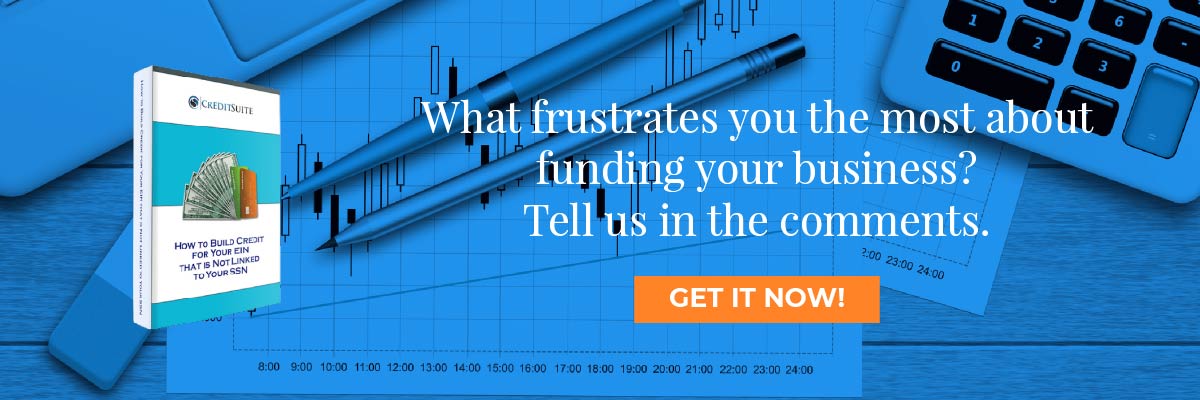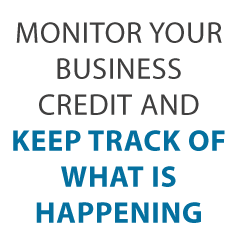- Connect With Us!
- (877) 600-2487
- info@creditsuite.com
Start Establishing Business Credit – We Show You How
Published By Janet Gershen-Siegel at April 6th, 2018
Start Establishing Business Credit Today
Do you about establishing business credit? We break down just what you need to know and show you what will work.
Establishing business credit means that your company gets opportunities you never believed you would. You can get cutting-edge equipment, bid on buildings, and cover the company payroll, even when times are a bit lean. This is particularly helpful in seasonal businesses. Because you can go for calendar months with few sales.
Every Small Business Needs to be Establishing Business Credit
Small business credit is credit in a small business’s name. It doesn’t attach to a business owner’s individual credit, not even when the owner is a sole proprietor and the sole employee of the small business.
Therefore, a business owner’s business and personal credit scores can be very different.
The Advantages of Establishing Business Credit
Because company credit is independent from individual, it helps to protect an entrepreneur’s personal assets, in the event of litigation or business insolvency.
Also, with two distinct credit scores, an entrepreneur can get two different cards from the same merchant. This effectively doubles buying power.
Another benefit is that even startup businesses can do this. Going to a bank for a business loan can be a recipe for frustration. But building company credit, when done properly, is a plan for success.
Individual credit scores are dependent on payments but also other factors like credit usage percentages.
But for business credit, the scores truly just hinge on if a small business pays its bills in a timely manner.
The Process of Establishing Business Credit
Establishing company credit is a process, and it does not occur automatically. A business will need to proactively work to build small business credit.
Nevertheless, it can be done readily and quickly, and it is much more rapid than building individual credit scores.
Merchants are a big part of this process.
Performing the steps out of sequence will cause repetitive denials. No one can start at the top with company credit. For example, you can’t start with retail or cash credit from your bank. If you do, you’ll get a rejection 100% of the time.
Business Fundability in Establishing Business Credit
A small business has to be fundable to credit issuers and vendors.
Consequently, a company will need a professional-looking web site and e-mail address. And it needs to have website hosting from a vendor such as GoDaddy.
And, business telephone and fax numbers should have a listing on ListYourself.net.
Additionally, the company phone number should be toll-free (800 exchange or comparable).
A company will also need a bank account dedicated only to it, and it must have all of the licenses essential for running.
Licenses
These licenses all have to be in the accurate, correct name of the company. And they must have the same business address and telephone numbers.
So keep in mind, that this means not just state licenses, but possibly also city licenses.
Learn more here and get started toward building business credit.
Working with the Internal Revenue Service to Start Establishing Business Credit
Visit the IRS website and get an EIN for the company. They’re free. Pick a business entity like corporation, LLC, etc.
A small business can begin as a sole proprietor. But they will probably want to change to a sort of corporation or an LLC.
This is in order to limit risk. And it will take full advantage of tax benefits.
A business entity will matter when it concerns tax obligations and liability in the event of a lawsuit. A sole proprietorship means the owner is it when it comes to liability and tax obligations. Nobody else is responsible.
Sole Proprietors Take Note
If you operate a small business as a sole proprietor, then at least be sure to file for a DBA. This is ‘doing business as’ status.
If you do not, then your personal name is the same as the business name. As a result, you can wind up being personally liable for all small business debts.
Also, per the Internal Revenue Service, with this structure there is a 1 in 7 probability of an IRS audit. There is a 1 in 50 probability for corporations! Prevent confusion and substantially lower the chances of an IRS audit at the same time.
Start Establishing Business Credit
Start at the D&B website and obtain a free D-U-N-S number. A D-U-N-S number is how D&B gets a small business into their system, to generate a PAYDEX score. If there is no D-U-N-S number, then there is no record and no PAYDEX score.
Once in D&B’s system, search Equifax and Experian’s websites for the small business. You can do this at fastcs.wpengine.com/reports. If there is a record with them, check it for correctness and completeness. If there are no records with them, go to the next step in the process.
In this manner, Experian and Equifax will have activity to report on.
Vendor Credit Tier
First you should establish trade lines that report. This is also called the vendor credit tier. Then you’ll have an established credit profile, and you’ll get a business credit score.
And with an established business credit profile and score you can begin to get credit in the retail and cash credit tiers.
These varieties of accounts have the tendency to be for the things bought all the time, like marketing materials, shipping boxes, outdoor work wear, ink and toner, and office furniture.
But first off, what is trade credit? These trade lines are credit issuers who will give you initial credit when you have none now. Terms are often Net 30, instead of revolving.
So, if you get an approval for $1,000 in vendor credit and use all of it, you need to pay that money back in a set term, like within 30 days on a Net 30 account.
Details
Net 30 accounts must be paid in full within 30 days. 60 accounts must be paid completely within 60 days. Unlike with revolving accounts, you have a set time when you must pay back what you borrowed or the credit you made use of.
To kick off your business credit profile the proper way, you ought to get approval for vendor accounts that report to the business credit reporting agencies. When that’s done, you can then use the credit.
Then repay what you used, and the account is on report to Dun & Bradstreet, Experian, or Equifax.
Vendor Credit Tier – It Helps
Not every vendor can help in the same way true starter credit can. These are merchants that will grant an approval with minimal effort. You also need them to be reporting to one or more of the big three CRAs: Dun & Bradstreet, Equifax, and Experian.
You want 5 to 8 of these to move onto the next step, which is the retail credit tier. But you may have to apply more than one time to these vendors. So, this is to prove you are reliable and will pay timely. Here are some stellar choices from us: https://oldcs.creditsuite.com/blog/5-vendor-accounts-that-build-your-business-credit/
Accounts That Don’t Report
Non-Reporting Trade Accounts can also be helpful. While you do want trade accounts to report to at the very least one of the CRAs, a trade account which does not report can nonetheless be of some value.
You can always ask non-reporting accounts for trade references. And credit accounts of any sort will help you to better even out business expenditures, thereby making financial planning less complicated. These are companies like PayPal Credit, T-Mobile, and Best Buy.
Retail Credit Tier
Once there are 5 to 8 or more vendor trade accounts reporting to at least one of the CRAs, then move to the retail credit tier. These are service providers which include Office Depot and Staples.
Only use your Social Security Number and date of birth on these applications for verification purposes. For credit checks and guarantees, use the small business’s EIN on these credit applications.
One example is Lowe’s. They report to D&B, Equifax and Business Experian. They want to see a D-U-N-S and a PAYDEX score of 78 or more.
Fleet Credit Tier
Are there 8 to 10 accounts reporting? Then move onto the fleet credit tier. These are service providers like BP and Conoco. Use this credit to purchase fuel, and to repair, and take care of vehicles. Only use your SSN and date of birth on these applications for verification purposes. For credit checks and guarantees, make certain to apply using the small business’s EIN.
One such example is Shell. They report to D&B and Business Experian. They want to see a PAYDEX Score of 78 or higher and a 411 company telephone listing.
Shell might say they want a certain amount of time in business or revenue. But if you already have adequate vendor accounts, that won’t be necessary. And you can still get an approval.
Learn more here and get started toward building business credit.
Cash Credit Tier
Have you been sensibly handling the credit you’ve up to this point? Then move to the cash credit tier. These are businesses such as Visa and MasterCard. Just use your Social Security Number and date of birth on these applications for verification purposes. For credit checks and guarantees, use your EIN instead.
One example is the Fuelman MasterCard. They report to D&B and Equifax Business. They want to see a PAYDEX Score of 78 or more. And they also want you to have 10 trade lines reporting on your D&B report.
Plus, they want to see a $10,000 high credit limit reporting on your D&B report (other account reporting).
Additionally, they want you to have an established company.
These are service providers like Walmart and Dell, and also Home Depot, BP, and Racetrac. These are usually MasterCard credit cards. If you have 14 trade accounts reporting, then these are in reach.
Learn more here and get started toward building business credit.
When Establishing Business Credit – Monitor It
Know what is happening with your credit. Make certain it is being reported and deal with any inaccuracies as soon as possible. Get in the practice of checking credit reports and digging into the details, and not just the scores.
We can help you monitor business credit at Experian and D&B for only $24/month. See: fastcs.wpengine.com/monitoring.
At Equifax, you can monitor your account at: www.equifax.com/business/business-credit-monitor-small-business. Equifax costs about $19.99.
Update Your Data
Update the details if there are mistakes or the data is incomplete. At D&B, you can do this at: https://iupdate.dnb.com/iUpdate/viewiUpdateHome.htm. For Experian, go here: www.experian.com/small-business/business-credit-information.jsp. So for Equifax, go here: www.equifax.com/business/small-business.
Fix Your Business Credit
So, what’s all this monitoring for? It’s to dispute any errors in your records. Mistakes in your credit report(s) can be fixed. But the CRAs typically want you to dispute in a particular way.
Get your company’s PAYDEX report at: www.dnb.com/about-us/our-data.html. Get your company’s Experian report at: www.businesscreditfacts.com/pdp.aspx?pg=SearchForm. And get your Equifax business credit report at: www.equifax.com/business/credit-information.
Disputes
Disputing credit report mistakes normally means you send a paper letter with copies of any evidence of payment with it. These are documents like receipts and cancelled checks. Never send the originals. Always send copies and keep the original copies.
Fixing credit report errors also means you specifically itemize any charges you challenge. Make your dispute letter as crystal clear as possible. Be specific about the issues with your report. Use certified mail so that you will have proof that you mailed in your dispute.
Dispute your or your business’s Equifax report by following the instructions here: www.equifax.com/small-business-faqs/#Dispute-FAQs.
You can dispute errors on your or your small business’s Experian report by following the instructions here: www.experian.com/small-business/business-credit-information.jsp.
And D&B’s PAYDEX Customer Service phone number is here: www.dandb.com/glossary/paydex.
A Word about Establishing Business Credit
Always use credit smartly! Don’t borrow beyond what you can pay off. Track balances and deadlines for payments. Paying promptly and completely will do more to elevate business credit scores than just about anything else.
Growing small business credit pays. Great business credit scores help a business get loans. Your credit issuer knows the company can pay its financial obligations. They recognize the business is for real.
The small business’s EIN attaches to high scores and lending institutions won’t feel the need to call for a personal guarantee.
Takeaways
Business credit is an asset which can help your small business for years to come. Learn more here and get started toward establishing business credit.

 " class="attachment-blog-single size-blog-single wp-post-image" alt="Get Business Credit Cards for New Businesses Credit Suite-Business Line of Credit Decoded" title="Get Business Credit Cards for New Businesses">>
" class="attachment-blog-single size-blog-single wp-post-image" alt="Get Business Credit Cards for New Businesses Credit Suite-Business Line of Credit Decoded" title="Get Business Credit Cards for New Businesses">>
